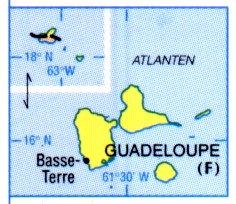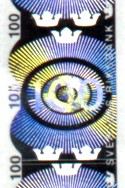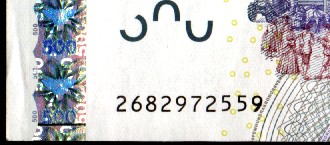
© Sedelmynt (J.A.), Changed 2010-07-23
The normal map of euro countries shows 12 countries (members of EU and participating in euro currency, EMU). Three other small countries (not members of EU) have an official agreement to use euro and also allowed to issue euro coins: Monaco, San Marino, Vatican (valid in all euro countries). Also Andorra has euro but is not allowed to issue coins. The result is 12 countries issuing notes and 15 countries issuing coins!! (and 16 countries using euro officially). The use of euro in parts of former Yugoslavia is without any agreement with ECB.

You can see several small maps on the backside of all notes. These show French overseas departments (Départements d'Outre-Mer, DOM) belonging to the European Union and using euro:
 |
Map of Guadeloupe and its "Dépendances" at 18°N
63°W from the European Commission:
(Iles du Nord de la Guadeloupe): Saint Martin (the Dutch part Sint Maarten does not use euro!!) Saint Barthélemy |
Some of these departments include (Dépendances) some islands far away from the main area (and using euro):
Euro is also in official use in French overseas "Collectivités Territoriales" which do not belong to the European Union but do belong to France (looks complicated!!):
French "Territoires d'Outre-Mer" (TOM) does not use euro and will have the currency CFP francs (currency code XPF):
The European currency should be listed in several stages:
|
 EU members |
 EU candidates |
*) Uncirculated euro banknotes issued by the Banque centrale du Luxembourg currently bear the code letter of the NCBs of those countries in which the banknotes for Luxembourg are produced. Luxembourg was in a monetary union with Belgium (1 BEF = 1 LUF) before the introduction of euro, so it was not used to produce its own banknotes (although Luxembourg produced some national notes). Luxembourg is the only EU country without any banknote printing facilities.
Originally the letter Y was reserved for Denmark and the letter W was reserved for Greece!! All the serial # prefix was chosen in reverse order according to the name in native language. This is still the order in all official tables produced by the European Union. Greece was not participating from start and both Y and W was reserved for not participating countries. Greece joined in 2001 and was given the wrong letter Y. There can be two different reasons:
The last digit of the serial number is a control digit (to make the right check sum). This is explain at Internet addresses:
See also pictures of euro notes at aes.iupui.edu/rwise/countries/Euro.html (Ronald Wise). He has also a lot of good pictures of modern Swedish notes.
The security features for the 5-20 euro notes are similar to the new Swedish 100 and 500 kronor notes from 2001: foil hologram, watermark with value in digits, look-trough picture, small bright yellow circles on both sides of the note, colour with different brightness dependant on viewing angle. These Swedish notes have a 0.2 mm break in the foil in every circa 8th note.
 Sweden 100 kr 2001: Break in foil between lower Three Crowns |
 Sweden 500 kr 2002: Break in foil below 500 Small yellow circles all over the note Look-through picture: half circle will form 500 |
Question to euro note owner: Have you seen any similar break in the foil on any 5-10-20 euro note? The break looks black when You tilt the note to see the hologram in its rainbow colour. If You tilt the note much more and see a metallic surface, then the break is extremely bright (brighter than the rest of the foil).
AB Tumba Bruk banknote printing office (and paper mill) did make test production of 20 € notes before the new Swedish 100-500 kronor notes were designed. The euro printer code is C for Tumba Bruk. It is now part of Crane & Co, Dalton, Massachusetts, USA (manufacturer of banknote paper for US Bureau of Engraving and Printing). The name of the company is changed to Crane AB (still located in Tumba, south of Stockholm).
You can see a “printer code” (short code with 6 characters) on the front side of the note (somewhat difficult to see). The three links above explain that the left letter in the “Short code” tells the name of the printer. Several printers may be used for each serial # prefix. Examples of this are “D001D4”, “R002D5”, “P001G5”. I have investigated two databases on Internet (links listed above) and found the following printer code used for each banknote. Some notes have two different printers (the percentage for each is listed). The databases have some wrong information, but I have tried to not list random notes. High value (200-500 €) notes may not exist for all countries, but new information indicates that these notes do exist in small quantities (name of printer is still unknown). I have put a question mark (?) for these notes.
|
Country |
Serial # prefix |
5 € |
10 € |
20 € |
50 € |
100 € |
200 € |
500 € |
|
Belgium |
Z |
T |
T |
T |
T |
T |
T |
T |
|
Greece |
Y |
N 25 % |
F 50 % |
N |
G 40 % |
G 70 % |
R |
? |
|
Germany |
X |
P |
R |
P |
P 30 % |
P |
R |
R |
|
Spain |
V |
M |
M |
M |
M |
M |
T |
T |
|
France |
U |
L |
L |
E 25 % |
L |
E 60 % |
T |
T |
|
Ireland |
T |
K |
K |
H 65 % |
K |
K |
? |
? |
|
Italy |
S |
J |
J |
J |
J |
J |
J |
J |
|
Luxembourg |
(R) |
- |
- |
- |
- |
- |
- |
- |
|
Netherlands |
P |
G 75 % |
G 20 % |
G |
G |
G |
G |
F |
|
Austria |
N |
F |
F |
F |
F |
F |
G |
F |
|
Portugal |
M |
U |
U |
U |
H |
P |
? |
? |
|
Finland |
L |
D |
D |
D |
D 40 % |
D |
D |
D |
Uncirculated euro banknotes issued by the Banque centrale du Luxembourg currently bear the code letter (serial # prefix) of the NCBs (National Central Bank) of those countries in which the banknotes for Luxembourg are produced.
It is possible that this is the printing plate number, numbered 001, 002, 003, etc.
I am convinced that this is the “Position code” in the printing sheet. The code has a letter + digit (A1, D3, I5, H2, etc.). You can also see a similar “position number” hidden in the serial number, but this is very complicated, with different digits for all countries and all printers. I have listed a few examples on my home page (in Swedish) but the essence of it could be understood: positions-nr. Reservations for error because I stopped writing these tables before I had investigated all notes.